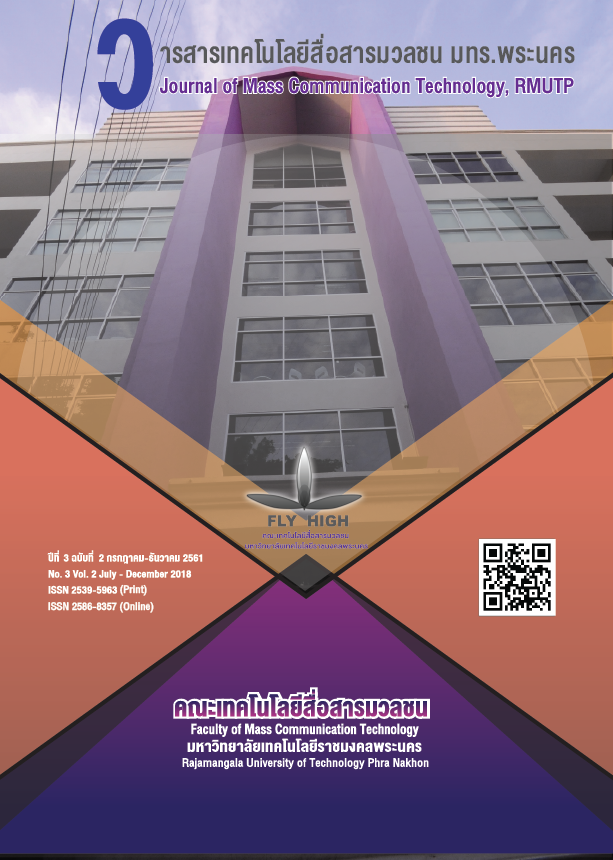รูปแบบการสื่อสารเชิงเชิญชวนในครอบครัวด้านการจูงใจให้ชอบสีชมพู
คำสำคัญ:
กลยุทธ์การปฏิบัติตาม, ทฤษฎีการเรียนรู้ทางสังคม, สีชมพู, การสื่อสารในครอบครัวบทคัดย่อ
บทความนี้อภิปรายทฤษฎีทางการสื่อสาร 2 ทฤษฎี คือ กลยุทธ์การปฏิบัติตาม และทฤษฎีการเรียนรู้ทางสังคม เพื่ออธิบายการสื่อสารในครอบครัวและบุคคลใกล้ชิดที่ทำให้ผู้เขียนบทความมีทัศนคติที่ดีต่อสีบางสี ทั้ง 2 ทฤษฎีนี้สามารถช่วยอธิบายการสื่อสารในครอบครัวของผู้เขียน 2 คนแรก กลยุทธ์การปฏิบัติตามที่ผู้ปกครองของทั้งสองใช้ในการเชิญชวนให้ชอบและไม่ชอบสี คือ การให้ก่อน การทำเพื่อให้ตนเองรู้สึกดี การทำให้คิดถึงคำชมจากผู้อื่น และการขู่ นอกจากนี้ ผู้เขียนยังค้นพบกลยุทธ์ในการเชิญชวน คือ การทำเพื่อให้ผู้อื่นรู้สึกดี ซึ่งควรจัดอยู่ในกลยุทธ์การปฏิบัติตามแต่ไม่เคยปรากฏในทฤษฎีนี้มาก่อน ผู้เขียนจึงแนะนำว่าการวิจัยเกี่ยวกับการสื่อสารในครอบครัวสามารถช่วยต่อยอดองค์ความรู้ทางด้านทฤษฎีการสื่อสารทั้งในทฤษฎีที่เกี่ยวข้องโดยตรง และทฤษฎีที่มักใช้อธิบายการสื่อสารในบริบทอื่น
เอกสารอ้างอิง
Amatyakul, S., & Polyorat, K. (2016). Brand personality. Executive Journal, 36(2), 89-101.
Arunrangsiwed, P. (2013). The Effects of Website for Temples in Bangyai and Bangkruay District on Thai Tourist Attractions. In The 5th International Science, Social Science, Engineer and Energy Conference 2013 (pp. 207-211). Kanjanaburi, Thailand: Suan Sunandha Rajabhat University.
Arunrangsiwed, P., Bunyapukkna, P., Ounpipat, N., & Inpayung, P. (2018). Wannabe Effect: The Study of Wishful Identification and Prosocial Media Effect. Manuscript submitted to an academic conference.
Arunrangsiwed, P. & Pasomsat, M. (2016). The evolution of Disney fairy tales: A meta-review of past studies. Suan Sunandha Rajabhat University Journal of Management Science, 3(1), 53-71.
Auimanachai, N. (2017). Video content with viral marketing. Executive Journal, 37(2), 22-28.
Bakker, I., van der Voordt, T., Vink, P., de Boon, J., & Bazley, C. (2015). Color preferences for different topics in connection to personal characteristics. Color Research & Application, 40(1), 62-71.
Bandura, A., & Walters, R. H. (1977). Social learning theory (Vol. 1). Englewood Cliffs, NJ: Prentice-hall.
Čavoški, S., & Markovic, A. (2015). Analysis of customer behaviour and online retailers strategies using the agent-based simulation. Management: Journal of Sustainable Business and Management Solutions in Emerging Economies, 77, 13-24.
Erdner, S. M., & Wright, C. N. (2018). The Relationship Between Family Communication Patterns and the Self-Efficacy of Student-Athletes. Communication & Sport, 6(3), 368-389.
Guilford, J. P., & Smith, P. C. (1959). A system of color-preferences. The American Journal of Psychology, 72(4), 487-502.
Guohua, Z. (2015). Analysis of graphic design and color application in tourism advertising. In The 2015 International Conference on Social Science and Technology Education. Sanya, China.
Hurlbert, A. C., & Ling, Y. (2007). Biological components of sex differences in color preference. Current biology, 17(16), R623-R625.
Kelly, L., Keaten, J. A., Cynthia, F., Duarte, I. B., Hoffman, P., & Michels, M. M. (2002). Family Communication Patterns and the Development of Reticence. Communication Education, 51(2), 202–209.
Khan, Z., & Habibullah, I. (2017). The Ukrainian conflict and options for conflict resolution. Journal of European Studies, 33(1), 16.
Koerner, A. F., & Fitzpatrick, M. A. (2002). Toward a theory of family communication. Communication theory, 12(1), 70-91.
MacElveen, P. (1978). Social networks. Clinical practice in psychosocial nursing: Assessment and intervention. New York: Appelton-Century-Crofts.
Madden, T. J., Hewett, K., & Roth, M. S. (2000). Managing images in different cultures: A cross-national study of color meanings and preferences. Journal of international marketing, 8(4), 90-107.
Madrigal, R. (1995). Cognitive and affective determinants of fan satisfaction. Journal of leisure research, 27(3), 205-207.
Marwell, G., & Schmitt, D. R. (1967). Dimensions of compliance-gaining behavior: An empirical analysis. Sociometry, 30, 350-364.
Miller, K. S., Kotchick, B. A., Dorsey, S., Forehand, R., & Ham, A. Y. (1998). Family communication about sex: What are parents saying and are their adolescents listening?. Family planning perspectives, 30(5), 218-235.
Navarro, R., Martínez, V., Yubero, S., & Larrañaga, E. (2014). Impact of gender and the stereotyped nature of illustrations on choice of color: Replica of the study by Karniol (2011) in a Spanish sample. Gender Issues, 31(2), 142-162.
Phakdiburut, W. (2017). Innovation communication for corporate brand management of Thai commercial bank: A case study of the Siam Commercial Bank Public Company Limited. Executive Journal, 37(1), 36-44.
Pinthapataya, S. (1999). Human behavior and self-development. Bangkok: Psychology and Guidance Program, Faculty of Education, Suan Sunandha Rajabhat University.
Racey, C., Franklin, A., & Bird, C. M. (2018). The processing of color preference in the brain (European Research Council project). Retrieved from http://dx.doi.org/10.1101/361006
Raut, V. P. (2017). An analytical view on color influencing consumer: paper advertisement-a study in Pune region. International Journal of Engineering Development and Research, 5(4), 554-558.
Richardson, B. (2004). New consumers and football fandom: The role of social habitus in consumer behaviour. Irish Journal of Management, 25(1), 88.
Srisontisuk, S. (2007). Social and culture of local community. Bangkok: SE-ED.
Suteetorn, B. (2017). Conflict and interpersonal conflict resolution. Executive Journal, 37(1), 54-67.
Tamminen, K. A., Gaudreau, P., McEwen, C. E., & Crocker, P. R. (2016). Interpersonal emotion regulation among adolescent athletes: A Bayesian multilevel model predicting sport enjoyment and commitment. Journal of sport and exercise psychology, 38(6), 541-555.
Wadhwani, R., & McMahon, D. J. (2012). Color of low-fat cheese influences flavor perception and consumer liking. Journal of dairy science, 95(5), 2336-2346.
Walters, J., Apter, M. J., & Svebak, S. (1982). Color preference, arousal, and the theory of psychological reversals. Motivation and emotion, 6(3), 193-215.
Weisgram, E. S., Fulcher, M., & Dinella, L. M. (2014). Pink gives girls permission: Exploring the roles of explicit gender labels and gender-typed colors on preschool children's toy preferences. Journal of Applied Developmental Psychology, 35(5), 401-409.
Wong, W. I., & Hines, M. (2015). Effects of gender color-coding on toddlers’ gender-typical toy play. Archives of sexual behavior, 44(5), 1233-1242.
Zellner, D. A., Bartoli, A. M., & Eckard, R. (1991). Influence of color on odor identification and liking ratings. The American Journal of Psychology, 104(4), 547-561.
ดาวน์โหลด
เผยแพร่แล้ว
รูปแบบการอ้างอิง
ฉบับ
ประเภทบทความ
สัญญาอนุญาต
Copyright (c) วารสารเทคโนโลยีสื่อสารมวลชน มทร.พระนคร
วารสารเทคโนโลยีสื่อสารมวลชน มทร.พระนคร อยู่ภายใต้การอนุญาต Creative Commons Attribution-NonCommercial-NoDerivatives 4.0 International License. (CC BY-Nc-ND 4.0) เว้นแต่จะระบุไว้เป็นอย่างอื่น โปรดอ่านหน้านโยบายของเราสำหรับข้อมูลเพิ่มเติมเกี่ยวกับการเข้าถึงแบบปิด ลิขสิทธิ์ และการอนุญาต




